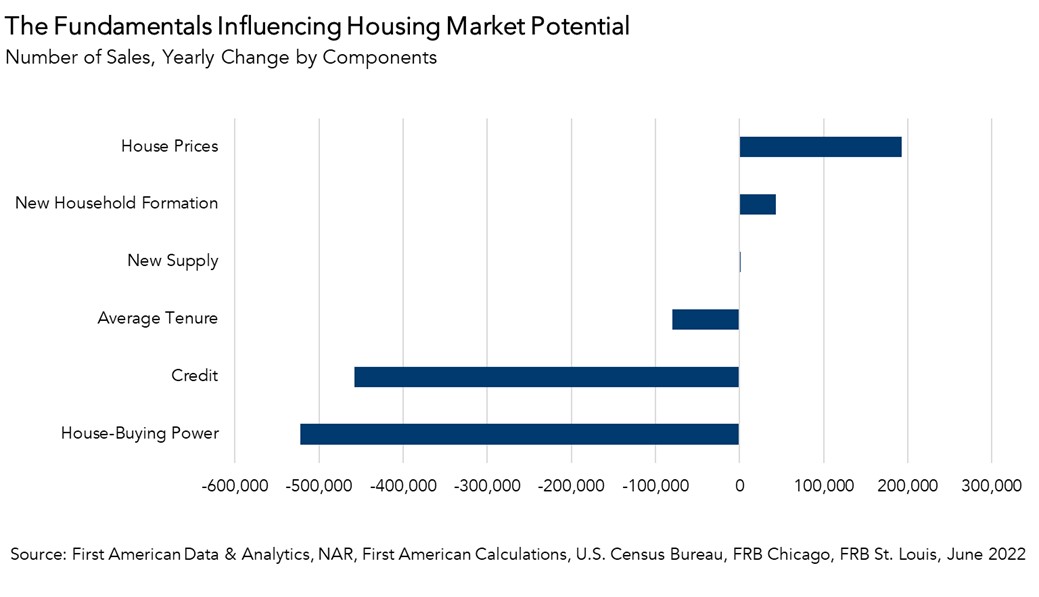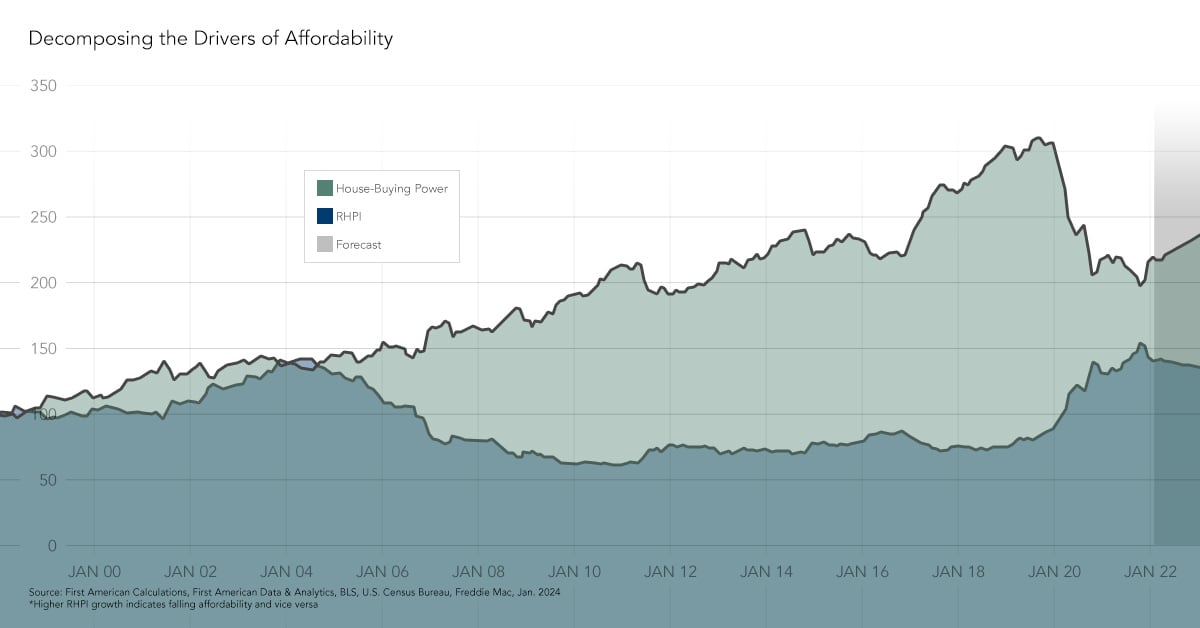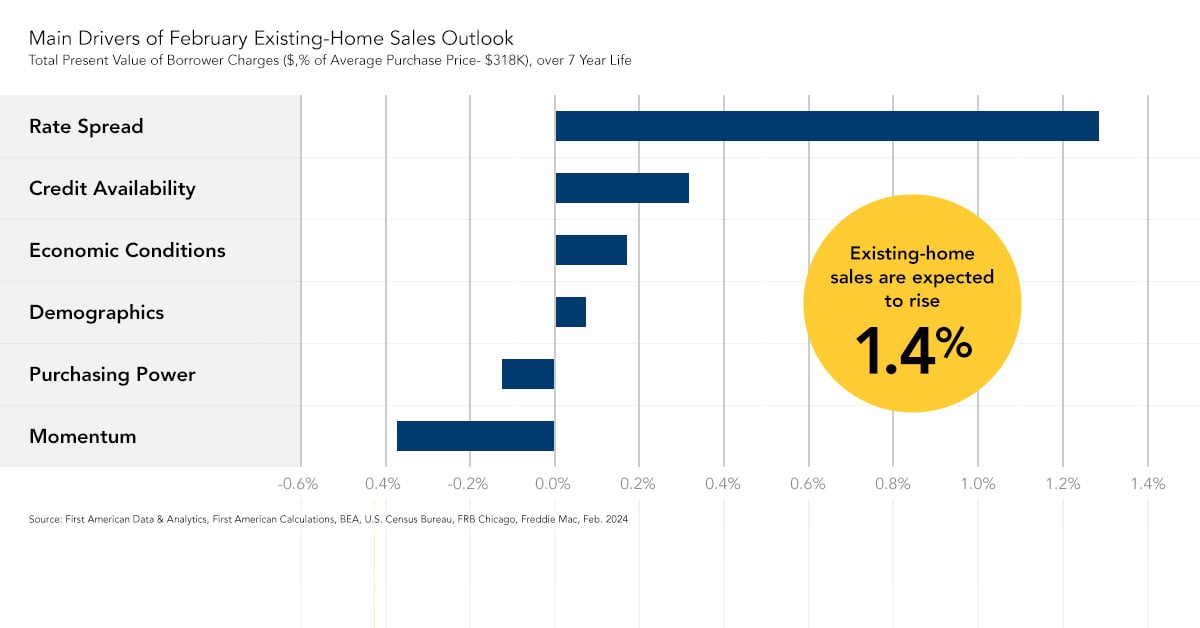The market potential for existing-home sales in June was estimated to be 5.47 million at a seasonally adjusted annualized rate (SAAR), down 2.5 percent compared to last month, and 13.1 percent lower than one year ago, which is near the same level as in early 2019.
While housing market potential remains strong from a historical perspective, it is down from pandemic highs. To understand why, one must look at how the fundamentals that drive the potential for existing-home sales have changed since June of last year. We can also examine what those changes mean for housing market potential in the near future.
“As the housing market adjusts to a post-pandemic norm with higher mortgage rates, housing market potential will subside from recent highs, but those highs were the exception and not the norm.”
Compared with June 2021, the market potential for existing-home sales has decreased by approximately 823,000 sales. Based on a dynamic simulation using our Potential Home Sales Model, we can identify the fundamentals influencing potential existing-home sales today relative to a year ago and segment them by fundamentals that are reducing or boosting housing market potential.
Fundamentals Reducing Housing Market Potential
- Declining House-Buying Power: House-buying power is how much home one can afford to buy given household income and the prevailing 30-year, fixed mortgage rate. Mortgage rates in June were 2.5 percentage points higher than they were a year ago. Holding household income constant at its June 2021 level, the increase in mortgage rates reduced house-buying power by $123,500. A 4.4 percent annual increase in household income helped to mitigate some of the impact of rising rates on affordability. Once accounting for the rise in household income, house-buying power fell by $108,000 since June 2021. The overall decline in house-buying power reduced housing market potential by 522,000 potential home sales.
- Tighter Credit Standards: When lending standards are tight, it becomes more difficult to qualify for a mortgage to buy a home. Likewise, when standards are loose, it’s easier to get a mortgage and buy a home. When home buyers are less likely to receive mortgages for a new home, they are also less likely to purchase a home. Credit standards tightened in recent months due to increasing economic uncertainty and monetary policy tightening. Compared with a year ago, credit tightening reduced housing market potential by 458,000 potential home sales.
- Increasing Tenure: According to the most recent data from June 2022, tenure length has increased from 10.4 years to 10.6 years compared with a year ago. The main reason? Low mortgage rates discourage existing homeowners from selling because there is no increased house-buying power other than that which comes from household income growth. Homeowners staying put reduced market potential by 80,000 potential home sales compared with one year ago.
Fundamentals Boosting Housing Market Potential
- Rising House Prices: As a homeowner gains equity in their home, they are more likely to consider using the equity to purchase a larger or more attractive home. However, if equity is low, homeowners are likely to remain ‘equity locked-in’ to their home. Compared with one year ago, house price appreciation increased housing market potential by nearly 193,000 potential home sales. This may be particularly important in an environment where house price growth is beginning to moderate, as sellers may be tempted to jump into the market to capture the higher sale price, yet these potential sellers must also contend with a rising interest rate environment.
- Rising Household Formation: The more households formed, the higher the demand for homes. The growth in household formation contributed to 43,000 potential home sales in June compared with one year ago.
- More New-Home Supply: The lack of supply and the fear of not being able to find something to buy keeps many existing homeowners from selling. As homebuilders bring more new homes to the market, the risk of not being able to find something to buy lessens and homeowners’ confidence in the decision to sell their existing home grows. Compared with last year, more new-home supply is entering the market, increasing housing market potential by 1,400 potential home sales.

How Has the Housing Market Fared?
Relative to last year, the reduction in demand stemming from falling house-buying power, tighter credit, and homeowners staying put resulted in a significant decline in the market potential for existing-home sales. Yet, despite these headwinds, market potential is currently near early 2019 levels. Households are continually forming and increasing demand for shelter, existing homeowners have record levels of home equity, and the fear of not being able to find something to buy is easing. As the housing market adjusts to a post-pandemic norm with higher mortgage rates, housing market potential will subside from recent highs, but those highs were the exception and not the norm.
June 2022 Potential Home Sales
For the month of June, First American updated its proprietary Potential Home Sales Model to show that:
- Potential existing-home sales decreased to a 5.47 million seasonally adjusted annualized rate (SAAR), a 2.5 percent month-over-month decrease.
- This represents a 56.9 percent increase from the market potential low point reached in February 1993.
- The market potential for existing-home sales decreased 13.1 percent compared with a year ago, a loss of 822,786 (SAAR) sales.
- Currently, potential existing-home sales is 1,320,000 (SAAR), or 19.4 percent below the pre-recession peak of market potential, which occurred in April 2006.
First American Deputy Chief Economist Odeta Kushi contributed to this post.
What Insight Does the Potential Home Sales Model Reveal?
When considering the right time to buy or sell a home, an important factor in the decision should be the market’s overall health, which is largely a function of supply and demand. Knowing how close the market is to a healthy level of activity can help consumers determine if it is a good time to buy or sell, and what might happen to the market in the future. That is difficult to assess when looking at the number of homes sold at a particular point in time without understanding the health of the market at that time. Historical context is critically important. Our potential home sales model measures what we believe a healthy market level of home sales should be based on the economic, demographic and housing market environments.
About the Potential Home Sales Model
Potential home sales measures existing-home sales, which include single-family homes, townhomes, condominiums and co-ops on a seasonally adjusted annualized rate based on the historical relationship between existing-home sales and U.S. population demographic data, homeowner tenure, house-buying power in the U.S. economy, price trends in the U.S. housing market, and conditions in the financial market. When the actual level of existing-home sales are significantly above potential home sales, the pace of turnover is not supported by market fundamentals and there is an increased likelihood of a market correction. Conversely, seasonally adjusted, annualized rates of actual existing-home sales below the level of potential existing-home sales indicate market turnover is underperforming the rate fundamentally supported by the current conditions. Actual seasonally adjusted annualized existing-home sales may exceed or fall short of the potential rate of sales for a variety of reasons, including non-traditional market conditions, policy constraints and market participant behavior. Recent potential home sale estimates are subject to revision to reflect the most up-to-date information available on the economy, housing market and financial conditions. The Potential Home Sales model is published prior to the National Association of Realtors’ Existing-Home Sales report each month.



